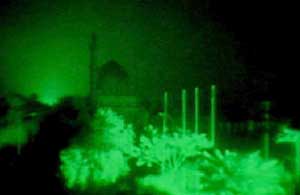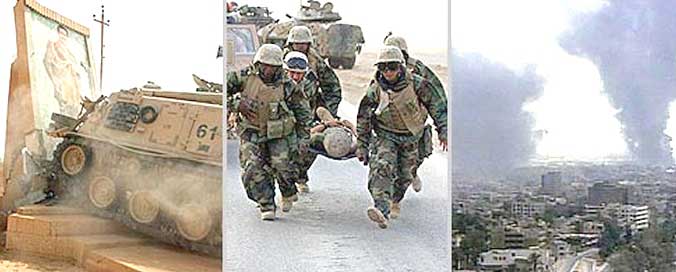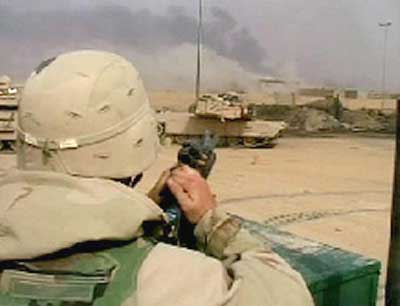From the southwest, Army soldiers who a day earlier seized the airport 10 miles from downtown Baghdad battled Iraqis on the highways leading into the capital. Black smoke poured into the sky over parts of Baghdad from fires set to obscure targets, and loud explosions were heard throughout the morning, punctuated by bursts of machine gun fire. In the past 24 hours, with U.S. forces nearing, Baghdad had taken on the look of a city under siege, with soldiers digging trenches and foxholes along the highway leading south
Throughout the night, the barrage of airstrikes and artillery on the city's edges rattled car alarms downtown into blaring life. Tens of thousands of residents fled for the north and northeast on Friday. The U.S. drive aimed
to isolate the capital, spokeswoman Air Force Cpt. Dani Burrows said at
U.S. Central Command in Qatar. "They're pretty much cut off in all directions,"
she said. "Pretty much what you've got here is a choke hold around Baghdad."
The Iraqis were fighting mostly with small weapons - Kalashnikov rifles and rocket-propelled grenades - suggesting they were mostly Saddam's Fedayeen fighters, rather than regular army or Republican Guards. Marines said they were also coming across many non-Iraqi fighters - mostly Jordanians and Egyptians. The U.S. commander of the air war said Friday that the Iraqi military had "very few organized forces left" after days of heavy pounding from coalition warplanes. "We're not softening them up," Lt. Gen. T. Michael Moseley said in a telephone interview with The Associated Press from his base in Saudi Arabia. "We're destroying them." In Friday's advances, Americans behind the main thrust passed burning vehicles, civilian and military, and hundreds of dead Iraqis, most in uniform. An abandoned military complex was littered with tanks, armored personnel carriers and empty tents. Along a highway to the south, the remains of a disappearing army: boots, berets and backpacks. Outside one empty barracks, U.S. forces blew the head off a large metal sculpture of President Saddam Hussein. Iraq threatened a counterattack against Saddam International Airport, rechristened Baghdad International after U.S. infantry took it in an assault before dawn Friday. In the sprawling airfield, soldiers were searching tunnels for Iraqi holdouts. Battles went on Friday afternoon along the roads between the airport and Baghdad's edge - though it was not clear if the Iraqis had launched an organized offensive. "There was lots of smoke and fire all along the roads leading into Baghdad, around the airport in particular," said Lt. Cmdr. Mark Johnson, a pilot who flew over the area in a bombing run. CNN reported that more than 400 Iraqis were killed during a tank fight north and east of the airport. Iraqi Information Minister Mohammed Saeed al-Sahhaf said the coalition forces at the airport would not get out alive. He threatened an "unconventional" attacks involving "commando and martyrdom operations in a very new, creative way." Iraqi forces may gather up civilians to assault the airport in a "human tide," warned Air Marshal Brian Burridge, the British commander in the Gulf. He told the British Broadcasting Corp. that "there were loudspeakers in southwest Baghdad signaling people should rise up and march on the airport." Meanwhile, members of the 3rd Infantry Division southeast of Baghdad cleared a path away from the Iraqi capital, skirmishing continuously with overmatched Iraqi forces. Most confrontations lasted only minutes, usually ending with overwhelming U.S. cannon, tank and machine gun fire - and then on to the next fight. The forces of the division's A Company, 3rd Battalion, 7th Infantry Regiment took out 20 Iraqi tanks trying to move north to defend Baghdad and swept through an abandoned military complex, finding the vacant tents and tons of munitions. At a vegetable patch outside Baghdad, members of the 3rd Infantry encountered a Republican Guard unit. Thirty seconds of cannon fire ended the fight, with two Guard members wounded and two more surrendering. "We got bombed last night, and most of our tanks were destroyed," said one of the prisoners, speaking through an interpreter. He and the other prisoner had ditched their Guard uniforms for civilian clothes. Between Kut and Baghdad, Marines reported that about 2,500 Republican Guards had surrendered. Marines fired on a truck that refused to stop for a checkpoint south of Baghdad on Friday, killing some civilians, a defense official in Washington said. An ABC News reporter with the unit said seven civilians riding cars behind the truck were killed, including three children. At one point Friday night, U.S. troops patrolling checkpoints south of Baghdad found an ambulance left behind after an accident. Inside, along with a stretcher, were rocket-propelled grenades, hand grenades, military uniforms and helmets. The ambulances had been racing in front of U.S. forces involved in the fighting near the Iraqi capital. It seemed the Iraqi forces might have used the medical vehicles to resupply its fighters on the ground. U.S. forces uncovered
a large ammunition cache in an industrial complex on the outskirts of Samawah,
about halfway between Baghdad and the Persian Gulf, according to a Fayetteville
(N.C.) Observer reporter with the unit. In the same building, they found
industrial pesticides, rat poison and other chemicals, as well as several
hundred gas masks and hundreds of decontamination kits.
|


